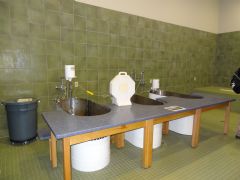At this point, I was reminded of a story I was told whilst working for the Football Association, by the former England first team kit man. On returning from the 2002 European Championships, the team's performances had been the subject of great media debate, mainly focussed around the apparent fatigue demonstrated by the players. All of the games had been characterised by rather lacklustre & abject second half showings, with players looking lethargic & heavy legged.
A couple of weeks later, I sat down to lunch with "Groges" & he started to complain about the "bloody sports scientists & physios...just make my job a nightmare". As I questioned his outburst, it was obvious that the main source of his displeasure focussed around the rather cumbersome & large portable ice baths we used at the time. "Half times are just a nightmare now," he continued, "I'm running around trying to hand out new shirts & players are running around, jumping in & out of the bloody ice baths!".
I was stunned, so stunned I asked him to repeat & further clarify his story. The national teams' protocol that we had set out at the FA during that period, stipulated that players should ice bath for 10 minutes immediately after the games. However, the two most senior players in the team at that time (who shall remain nameless) had decided that this practice wasn't to their liking & was preventing them getting through the press & back to the hotel as quickly as they wanted. As a result, they had successfully lobbied the then manager (who was renowned for pandering to the senior players' every wish) to get the ice baths out of the way at half time. Without our sports science staff in Portugal & the recovery provision being directed by the manager's "old faithful" sports scientist from Italy, there was no objection voiced.
Go figure the players looked lethargic in the second half of games; they were trying to compete in a state of neuromuscular compromise!
Earlier this month, Schmid, Moffat & Gutierrez published a paper that goes some way to demonstrating this very phenomenon. Using a population of 20 healthy subjects, they investigated the effects of knee joint ice application on ground reaction force, knee angle & drop jump height, using a randomised control trial. Following a pre-test trial, crushed ice bags were applied to the knee joints of the experimental group participants, for 20 minutes whilst they rested, whereas the control group participants rested without ice application.
All subjects were then immediately retested & the results demonstrated significant decreases in the average braking phases & increases in foot contact time in the experimental subjects. In addition, there were several non-significant trends towards force reduction identified. Due to heterogeneity in jump height baseline measures, this data was omitted from the conclusions.
Whilst the experimental group was relatively small & there were several limitations of the study including a lack of skin or subcutaneous temperature measurements & an absence of hip & ankle joint kinematics, the results certainly illustrate an effect on the kinetic chain, that is likely neuromuscular in nature.
This is an area that definitely requires further research but this should not prevent the findings being considered in the sports physiotherapy environment, when clinicians or athletes are reasoning that ice should be applied to an injured area, despite an intended continuation of sports participation by the athlete.
A review by Nolan, Jr., Galantino & Buccafurni, also published earlier this month, compared several studies investigating the implications of cryotherapy on force production in neuromuscular electrical stimulation (NMES). Clinically this is an interesting review, particularly for those operating in many American sports environments. where the treatment of choice for just about every injury coming through the door is "ice & stim".
The authors reviewed 11 studies that fulfilled the inclusion criteria, published between 1980 & 2010. They concluded that whilst short term ice application (< 5 minutes) increased tolerance to strong NMES-elicited contractions, longer term applications (> 20 minutes) affected muscle force production.
A consensus suggested that the type of cold modality, duration of cold application, thickness of subcutaneous adipose tissue, cutaneous blood flow, type of electrode & skin preparation should all be considered when applying cryotherapy before or during NMES.
So the next time an athlete informs you that they are "going to ice", make sure you establish what their subsequent activity levels will consist of before you throw them the ice bag or plug in the Game Ready.

